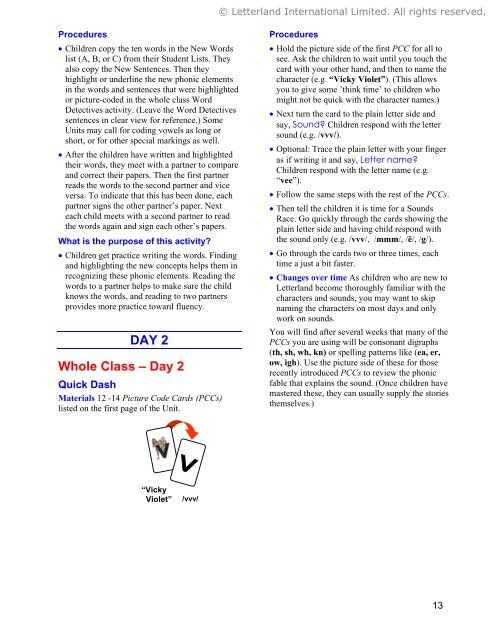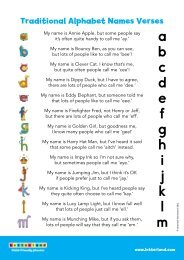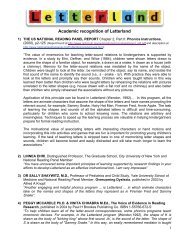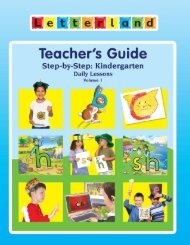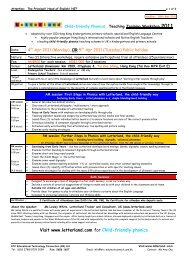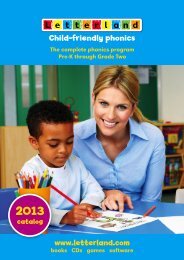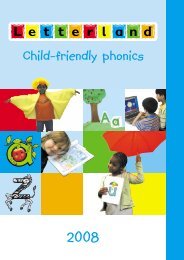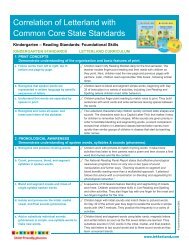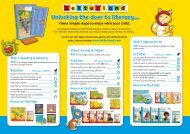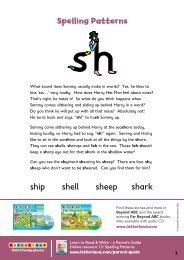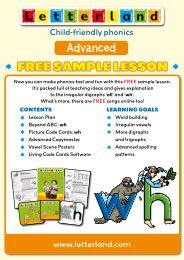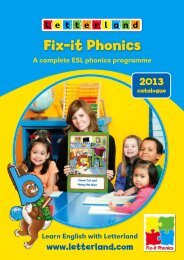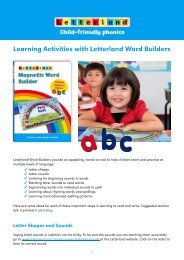Teacher's Guide - Letterland
Teacher's Guide - Letterland
Teacher's Guide - Letterland
Create successful ePaper yourself
Turn your PDF publications into a flip-book with our unique Google optimized e-Paper software.
© <strong>Letterland</strong> International Limited. All rights reserved.Procedures• Children copy the ten words in the New Wordslist (A, B, or C) from their Student Lists. Theyalso copy the New Sentences. Then theyhighlight or underline the new phonic elementsin the words and sentences that were highlightedor picture-coded in the whole class WordDetectives activity. (Leave the Word Detectivessentences in clear view for reference.) SomeUnits may call for coding vowels as long orshort, or for other special markings as well.• After the children have written and highlightedtheir words, they meet with a partner to compareand correct their papers. Then the first partnerreads the words to the second partner and viceversa. To indicate that this has been done, eachpartner signs the other partner’s paper. Nexteach child meets with a second partner to readthe words again and sign each other’s papers.What is the purpose of this activity?• Children get practice writing the words. Findingand highlighting the new concepts helps them inrecognizing these phonic elements. Reading thewords to a partner helps to make sure the childknows the words, and reading to two partnersprovides more practice toward fluency.DAY 2Whole Class – Day 2Quick DashMaterials 12 -14 Picture Code Cards (PCCs)listed on the first page of the Unit.Procedures• Hold the picture side of the first PCC for all tosee. Ask the children to wait until you touch thecard with your other hand, and then to name thecharacter (e.g. “Vicky Violet”). (This allowsyou to give some ’think time’ to children whomight not be quick with the character names.)• Next turn the card to the plain letter side andsay, Sound? Children respond with the lettersound (e.g. /vvv/).• Optional: Trace the plain letter with your fingeras if writing it and say, Letter name?Children respond with the letter name (e.g.“vee”).• Follow the same steps with the rest of the PCCs.• Then tell the children it is time for a SoundsRace. Go quickly through the cards showing theplain letter side and having child respond withthe sound only (e.g. /vvv/, /mmm/, /ĕ/, /g/).• Go through the cards two or three times, eachtime a just a bit faster.• Changes over time As children who are new to<strong>Letterland</strong> become thoroughly familiar with thecharacters and sounds, you may want to skipnaming the characters on most days and onlywork on sounds.You will find after several weeks that many of thePCCs you are using will be consonant digraphs(th, sh, wh, kn) or spelling patterns like (ea, er,ow, igh). Use the picture side of these for thoserecently introduced PCCs to review the phonicfable that explains the sound. (Once children havemastered these, they can usually supply the storiesthemselves.)“VickyViolet”/vvv/13


